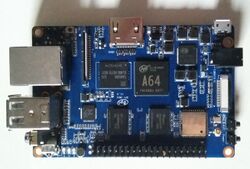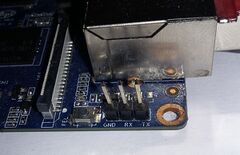Sinovoip Banana Pi M64
Banana Pi M64 Ultra is a A64 based development board produced by Sinovoip.
Despite its name, the M64 is incompatible to previous Banana Pi boards (Banana Pi/M1/M1+/Pro/M2/M2+/M3), due to a different SoC - requiring different boot loaders and drivers. It's another attempt to cash in on the Banana Pi's popularity with a SBC only sharing brand, name, form factor and GPIO header.
| Sinovoip Banana Pi M64 | |
|---|---|
 | |
| Manufacturer | Sinovoip |
| Dimensions | 92mm x 60mm x 20mm |
| Release Date | July 2016 |
| Website | M64 product page |
| Specifications | |
| SoC | A64 @ 1152 Mhz |
| DRAM | 2GiB DDR3 @ 672 MHz (SKhynix H5TQ4G83AFR x4) |
| NAND | 8 GB eMMC (Samsung KLM8G1WEPD-B031) |
| Power | DC 5V @ 2A (4/1.7mm barrel plug), Li-Ion battery connector |
| Features | |
| Video | HDMI Type A - full size |
| Audio | 3.5mm headphone plug, HDMI, internal microphone |
| Network | WiFi 802.11 b/g/n (Ampak AP6212), 10/100/1000Mbps Ethernet (Realtek 8211E) |
| Storage | µSD, eMMC 5.0 |
| USB | 2 USB2.0 Host via Terminus Technology 4-Port hub, 1 USB2.0 OTG (micro-B) |
| Other | IRDA, reset & power button |
Identification
The PCB has the following silkscreened on it:
BPi-M64 v1.0
alongside with the BananaPi (Bpi) logo.
Sunxi support
Current status
From the software point of view this device is similar to the Pine64 (similar DRAM, same Ethernet and PMIC), so basic support should work with some Pine64 image. In fact the manufacturer seems to offer Pine64 images based on longsleep's builds.
Images
End Users: Here are links to current images that are not community supported:
- http://www.banana-pi.org/m64-download.html
- http://forum.banana-pi.org/t/bpi-m64-new-image-bpi-m64-win10iotcore10586-beta0-1/2108
Manual build
You can build things for yourself by following our Manual build howto and by choosing from the configurations available below.
U-Boot
Mainline U-Boot
Use the bananapi_m64_defconfig build target.
Linux Kernel
Mainline kernel
Use the sun50i-a64-bananapi-m64.dtb device-tree binary.
Expansion Port
The Banana Pi M64 has the usual 40-pin, 0.1" Raspberry Pi 2 compatible connector with several low-speed interfaces.
| 2x20 Header | |||
|---|---|---|---|
| 1 | 3.3V | 2 | 5V |
| 3 | TWI1_SDA / PH03 | 4 | 5V |
| 5 | TWI1_SCK / PH02 | 6 | GND |
| 7 | UART3_RTS / PH06 | 8 | UART2_TX / PB0 / JTAG-MS0 |
| 9 | GND | 10 | UART2_RX / PB1 / JTAG-CK0 |
| 11 | UART3_CTS / PH07 | 12 | UART2_CTS/ PB3 / JTAG-DI0 |
| 13 | DMIC-CLK / PH10 | 14 | GND |
| 15 | DMIC-DIN/ PH11 | 16 | UART2_RTS / PB2 / JTAG-DO0 |
| 17 | 3.3V | 18 | PD4 |
| 19 | SPI1_MOSI / PD2 | 20 | GND |
| 21 | SPI1_MISO / PD3 | 22 | PC0 / SPI0-MOSI |
| 23 | SPI1-CLK / PD1 / UART3-RX | 24 | SPI1-CS / PD0 / UART3-TX |
| 25 | GND | 26 | PC2 / SPI0-CLK |
| 27 | PC4 | 28 | PC3 / SPI0-CS |
| 29 | PC7 | 30 | GND |
| 31 | PCM0-BCLK / PB5 | 32 | PCM0-DIN / PB7 |
| 33 | PCM0-SYNC / PB4 | 34 | GND |
| 35 | PCM0-DOUT / PB6 | 36 | PL9 / S_TWI-SDA |
| 37 | PL12 | 38 | PL7 |
| 39 | GND | 40 | PL8 / S_TWI-SCK |
Pin PC1, which carries the SPI0-MISO signal, is not available on a header, since it is connected to the eMMC chip. So booting from a SPI flash connected to header pins will not work on the Banana Pi M64.
Tips, Tricks, Caveats
FEL mode
The FEL button (called U-Boot key in the manual) triggers FEL mode.
The boot order is: SD card first, then eMMC, then FEL. Pressing the FEL button always triggers FEL mode. A SD card without an eGON header will be skipped, it continues on eMMC then. If boot0 fails to locate U-Boot, it will enter FEL mode.
USB
The two type A receptacles are connected to a Terminus Technology Inc. 4-Port hub on the lower PCB side that is connected to the SoC. PCB traces on the board provide a 3rd USB port connected to the hub on solder wholes next to the 40 pin GPIO header (polarity 'information').
ESD & over-current protections
Based on the schematic Rev 1.1 (September 18, 2016) the board incorporates the following protections:
| Protections
x - no protection, ESD - Electrostatic Discharge, OC - Over-current |
Comments | |||
|---|---|---|---|---|
| 1 | DCIN (power) | x | x | No power supply bypass |
| 2 | Micro SD | x | x | |
| 3 | Camera | x | x | |
| 4 | Dual USB1 | ESD | x | |
| 5 | Micro USB OTG | ESD | OC | Over-current protection by U8 (unknown value) |
| 6 | HDMI | ESD | x | |
| 7 | MIPI-DSI | x | x | |
| 8 | Ethernet | x | N/A | Over-current protection is not applicable |
| 9 | GPIO | x | x | |
| 10 | Debug UART | x | ? | |
| 11 | Audio jack | ESD | N/A | Output current is internally limited by SoC |
Adding a serial port
There is a three pin UART header next to the Ethernet socket, it is connected to UART0. The pins are clearly labelled with GND, RX and TX. Attach a 3.3V UART interface as described in the UART howto.
Pictures
See also
From a software point of view there is not much difference from the Pine64, which is the main development vehicle for the A64 SoC support. So please check the Pine64 page for further information.
Manufacturer images
The official BananaPi M64 page provides already some images, those with Linux based on longsleep's Pine64 images. Be aware that they are based on already outdated BSP kernel/u-boot versions and partially use an ARMv6 userland causing unnecessary performance implications: http://www.banana-pi.org/m64-download.html


